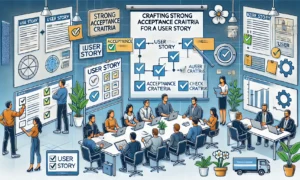Introduction
In product management, the true value of a product is measured by its ability to solve real problems, enhance user experience, and drive business outcomes. The success of a product can be gauged not only by its adoption rate but also by the tangible impact it creates for businesses and individuals. This case study delves into the impact of a product launch on both the business and its customers, demonstrating how thoughtful product management and innovation can lead to measurable results.
Case Study: Transforming Customer Experience and Business Performance with a New SaaS Product
Background: A growing SaaS (Software-as-a-Service) company developed an AI-powered customer support tool aimed at streamlining customer service operations for small and medium-sized businesses (SMBs). The tool utilized machine learning to automate customer inquiries, offer personalized responses, and route more complex queries to human agents. The goal was to reduce customer service costs, improve response times, and increase customer satisfaction.
1. The Problem: Addressing Pain Points in Customer Support
The company’s initial challenge was to address inefficiencies in customer service. Many SMBs struggled with managing a high volume of customer inquiries without sufficient resources. These pain points included:
- High Operational Costs: Customer service teams were overwhelmed by routine queries, requiring more human agents to manage the workload.
- Long Response Times: Customers experienced long wait times, resulting in frustration and a decline in satisfaction.
- Inconsistent Service: Without adequate automation, service quality varied, and customers did not receive consistent responses to their inquiries.
2. Product Solution: AI-Powered Customer Support Tool
Product Features:
- AI Chatbot: An intelligent chatbot designed to handle common queries, reducing the load on human agents and providing immediate assistance.
- Machine Learning: Over time, the system learns from previous interactions, allowing it to provide more accurate responses.
- Omnichannel Support: The product integrated with various channels such as email, live chat, and social media to provide seamless customer support.
- Escalation Management: Complex issues were automatically escalated to human agents for more personalized attention.
How the Product Was Designed to Drive Business Impact:
- Cost Reduction: By automating routine tasks, businesses could reduce the number of support agents needed, cutting down operational costs.
- Speed and Efficiency: The AI chatbot improved response times, allowing customers to receive answers almost instantly, even during high-traffic periods.
- Consistency and Accuracy: Automated responses ensured that customers received consistent, accurate information, enhancing service quality.
- Scalability: As SMBs grow, they can scale customer support operations without needing to hire a proportional increase in human agents.
3. Measuring the Impact: Business and Customer Success
Impact on the Business:
- Cost Savings: After implementing the tool, businesses reported a 30% reduction in customer service costs. Automation cut the need for additional hires, while reducing the number of repetitive tasks performed by human agents.
- Increased Productivity: By automating routine inquiries, human agents could focus on more complex cases, improving the overall productivity of the support team.
- Improved Customer Retention: Companies using the tool saw a 20% increase in customer retention rates due to faster, more reliable support.
- Higher Revenue: Enhanced customer satisfaction led to positive word-of-mouth, increasing customer acquisition and contributing to a 15% growth in revenue for the first quarter post-launch.
Impact on Customers:
- Faster Response Times: Customers experienced a 50% reduction in response time, leading to higher satisfaction and fewer abandoned queries.
- 24/7 Support: The tool provided customers with round-the-clock support, helping businesses cater to global audiences and non-business hours.
- Personalized Experiences: Through machine learning, customers received more personalized responses, which improved their overall experience with the brand.
- Consistency in Service: The AI-driven tool ensured that responses were standardized and reliable, reducing the chance of human error and enhancing customer trust.
4. Competing Products: Understanding the Market Landscape
The competitive landscape included several established customer support tools such as Zendesk, Freshdesk, and Intercom, which offered a mix of live chat, email support, and knowledge bases. However, these tools often required businesses to heavily rely on human agents for handling repetitive tasks, which increased costs.
How This Product Differentiated:
- AI and Automation: Unlike competitors, this tool’s AI-powered automation was the key differentiator. It reduced dependency on human agents, offering better scalability for growing businesses.
- Customization: The product allowed businesses to customize the chatbot to match their tone, branding, and specific workflows, providing a more tailored experience than off-the-shelf solutions.
- Affordability: Positioned as a cost-effective solution for SMBs, it delivered enterprise-level automation at a fraction of the price of larger competitors.
5. Development Methods: Agile and Data-Driven Decision Making
The product development team followed Agile methodologies, which allowed for continuous iteration and rapid response to user feedback:
- MVP Launch: The initial version of the product was released as a minimum viable product (MVP) to gather user feedback quickly and make improvements based on real-world use.
- User-Centric Testing: Extensive beta testing with SMB customers helped refine the product, especially in terms of response accuracy and integration with various communication channels.
- Continuous Improvement: The team used data analytics to track performance metrics such as response time, user satisfaction, and the volume of automated inquiries handled. Insights from this data informed product updates and improvements.
6. Marketing Strategy: Driving Adoption and Scaling Reach
The product’s marketing strategy focused on showcasing its tangible benefits to SMBs through:
- Targeted Campaigns: Ads and content marketing targeted at small and medium-sized business owners, highlighting cost savings and productivity improvements.
- Customer Success Stories: Case studies and testimonials from early adopters were used to build trust and credibility with new customers.
- Free Trials: Offering a limited free trial allowed businesses to experience the tool’s impact firsthand, making it easier to convert leads into paying customers.
- Partnerships and Integrations: The tool was integrated with popular business management platforms like Shopify and HubSpot, expanding its reach to potential customers already using those platforms.
7. Lessons Learned: Key Takeaways for Future Product Development
- Prioritize User Pain Points: Understanding the core pain points of your target customers is essential. In this case, automating repetitive tasks and reducing operational costs were crucial to success.
- Data-Driven Iteration: Continuous improvement based on data insights and user feedback is vital to product success. This approach ensures that the product evolves to meet changing needs.
- Clear Value Proposition: When launching a product in a competitive market, a clear and unique value proposition helps differentiate your offering. In this case, AI-powered automation and cost-effectiveness were key differentiators.
- Scalability is Essential: Building products that can grow with your customers is essential. Offering scalable solutions for SMBs provided the company with a competitive edge.
- Effective Marketing Can Accelerate Adoption: Clear messaging, free trials, and user testimonials can be powerful tools for accelerating product adoption and convincing users of a product’s value.
Conclusion
This case study illustrates how a well-executed product launch can create significant impact, both for businesses and their customers. By addressing key pain points such as cost inefficiencies and slow response times, the AI-powered customer support tool not only transformed the customer experience but also helped SMBs improve their bottom line. The lessons learned from this product development journey offer valuable insights for any product manager looking to create solutions that drive real, measurable results.
Disclaimer
Posts in the Notebook are written by individual members and reflect personal insights or opinions. Please verify any information independently. If you have any concerns, notify the admin immediately so we can take action before any legal steps are taken.





